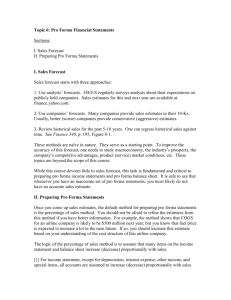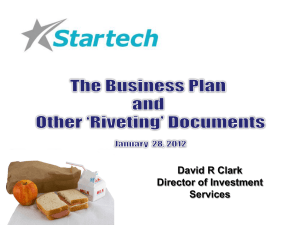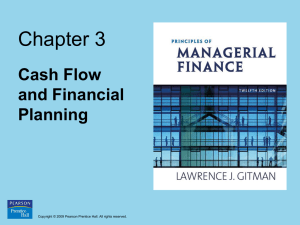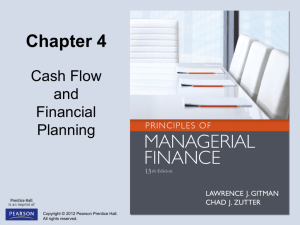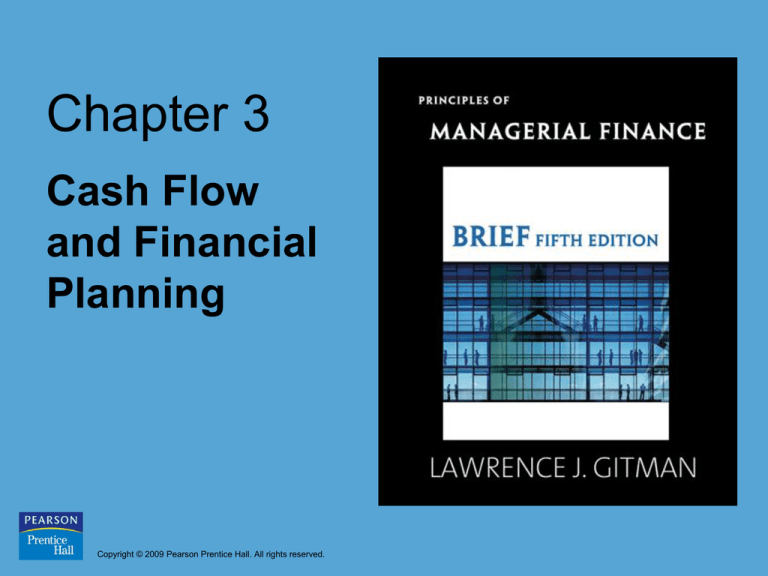
Chapter 3
Cash Flow
and Financial
Planning
Copyright © 2009 Pearson Prentice Hall. All rights reserved.
Learning Goals
1. The effect of depreciation on the firm’s cash flows.
2. Calculate depreciation using MACRS.
3. Operating cash flows.
4. Financial planning process.
5. Preparation and use of the cash budget.
6. Preparation and use of pro forma financial
statements.
Copyright © 2009 Pearson Prentice Hall. All rights reserved.
3-2
Depreciation: Depreciation & Cash Flow
• Financial managers are more concerned with cash
flows than profits.
• By lowering taxable income, depreciation (and other
non-cash expenses) creates a tax shield and enhances
cash flow.
• Depreciation for tax purposes is determined by using
the modified accelerated cost recovery system
(MACRS).
Copyright © 2009 Pearson Prentice Hall. All rights reserved.
3-3
Depreciation:
Depreciable Value & Depreciable Life
• Under MACRS:
– the depreciable value of an asset is its full cost, including
installation cost.
– No adjustment is made for expected salvage value.
– The depreciable life of an asset is determined by its
MACRS class.
• MACRS property classes and rates are shown in Table 3.1
and Table 3.2 in your text (pp. 97-8).
Copyright © 2009 Pearson Prentice Hall. All rights reserved.
3-4
Sources of Cash Flows
• There a number of sources of cash flows for a
business:
– Operating flows (from sale of the firm’s products)
– Investment flows (purchase or sale of fixed assets,
for example)
– Financing flows (borrow money or repay debt, for
example)
• Healthy firms generate most cash flows from
operations, so we focus on them.
Copyright © 2009 Pearson Prentice Hall. All rights reserved.
3-5
Operating Cash Flow
• Operating cash flow is the cash flow generated
from normal operations—from the production
and sale of its goods and services.
• The text makes a distinction between “operating
cash flow” and “cash flow from operations.”
They are the same thing; however there are two
methods of estimating operating cash flow.
Copyright © 2009 Pearson Prentice Hall. All rights reserved.
3-6
Operating Cash Flow
• OCF may be calculated as follows:
NOPAT = EBIT x (1 – T)
OCF = NOPAT + Depr & other noncash charges
Where: EBIT is Earnings Before Interest and
Taxes
NOPAT is Net Operating Profit After Taxes
Copyright © 2009 Pearson Prentice Hall. All rights reserved.
3-7
The Financial Planning Process
• Two key aspects of financial planning are cash
planning and profit planning.
– Cash planning involves the preparation of the
firm’s cash budget.
– Profit planning involves the preparation of pro
forma financial statements.
Copyright © 2009 Pearson Prentice Hall. All rights reserved.
3-8
The Financial Planning Process
• Short-term financial plans typically cover a
one year operating period.
– Key inputs: sales forecast and other operating and
financial data.
– Key outputs: the cash budget and pro forma
financial statements.
Copyright © 2009 Pearson Prentice Hall. All rights reserved.
3-9
Cash Planning: Cash Budgets
• The cash budget is a statement of the firm’s
planned inflows and outflows of cash.
– Typically, monthly budgets are developed covering a
1-year time period.
– The cash budget begins with a sales forecast.
Copyright © 2009 Pearson Prentice Hall. All rights reserved.
3-10
Cash Planning: Cash Budgets (cont.)
Table 3.7 The General Format of the Cash Budget
Copyright © 2009 Pearson Prentice Hall. All rights reserved.
3-11
Uncertainty in the Cash Budget
• “Planning is everything; plans are nothing.”
• One way to cope with cash budgeting
uncertainty is to prepare several cash budgets
based on several forecasted scenarios (e.g.,
pessimistic, most likely, optimistic).
Copyright © 2009 Pearson Prentice Hall. All rights reserved.
3-12
Profit Planning: Pro Forma Statements
• Pro forma financial statements: projections
• The inputs required to develop pro forma
statements include:
– Financial statements from the preceding year
– The sales forecast
– Key assumptions about a number of factors
(planned purchase of fixed assets, dividend
payments, etc.)
Copyright © 2009 Pearson Prentice Hall. All rights reserved.
3-13
Profit Planning: Pro Forma Financial
Statements (cont.)
Preparing the Pro Forma Income Statement
– A simple method for developing a pro forma income
statement is the “percent-of-sales” method.
– This method starts with the sales forecast and then
expresses the cost of goods sold, operating expenses,
and other accounts as a percentage of projected
sales.
Copyright © 2009 Pearson Prentice Hall. All rights reserved.
3-14
Profit Planning: Pro Forma Financial
Statements (cont.)
•Clearly, some of the firm’s expenses are variable,
while others are fixed.
•As a result, the strict application of the percent-ofsales method is a bit naïve.
•One way to generate a more realistic pro forma income
statement is to segment the firm’s expenses into fixed
and variable components.
Copyright © 2009 Pearson Prentice Hall. All rights reserved.
3-15
Profit Planning: Pro Forma Financial
Statements (cont.)
Preparing the Pro Forma Balance Sheet
– One approach to develop the pro forma balance sheet
is what our text calls the judgmental approach.
– Under this method, the values of some balance sheet
accounts are estimated and the company’s external
financing requirement is used as the balancing
account.
Copyright © 2009 Pearson Prentice Hall. All rights reserved.
3-16
Uncertainty in the Pro Forma Statements
• As with the cash budget, the pro forma income
statement and balance sheet are no better than
the sales forecast. The planning process must
consider the impact of higher and lower sales on
the financial statements: in other words, do
multiple pro formas using different sales
forecasts.
Copyright © 2009 Pearson Prentice Hall. All rights reserved.
3-17

